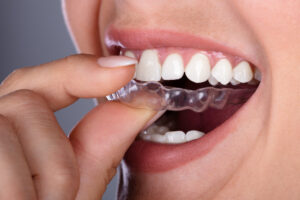Everyone wants a perfect smile with straight, white teeth, but some people might need a little extra help to reach that goal. Thankfully, it is possible to get this wish granted due to a pair of orthodontic devices called aligners.
Aligners are not entirely different from braces; while they perform practically the same job, they vary in design. Braces are connected by wires that enable the teeth to move. Aligners, on the other hand, are invisible, fitted mouthpieces that slip on the teeth.
If you are reading this article, the chances are the time has come for you to work on your teeth. But which mouthpiece would you use? A clear aligner like the MTM ® Clear Aligner or traditional braces? Your dentist will help you decide which option works better for you. Nonetheless, it helps to do a little research as well.
About MTM ® Clear Aligner
The MTM ® Clear Aligner focuses on patients who wish to realign their eight front teeth. MTM, which means Minor Tooth Movement uses a set of customized trays to readjust the positioning of the tooth. It is also used to improve teeth conditions such as overcrowding, overbite, and crossbite.
You will need to consult with a dentist to determine if you are the right candidate for the MTM ® Clear Aligner system. Once it has been confirmed, you will then have a mould of your teeth to create the custom trays. These typically take 3-4 weeks to be completed. When you start to wear the aligner, ensure that you do so for at least 20-22 hours per day for the best results. Until you are done with treatment, you will have to replace your trays every two weeks.
Pros and Cons of The MTM ® Clear Aligner
Here are some pros and cons of the MTM system:
Pros:
- Easily removable
- Transparent
- No need for any food restrictions
- Treatment can be quick depending on your condition
Cons:
- Focuses on only the front eight teeth
- Some patients have issues with biting
- Aligners could easily get misplaced
About Traditional Braces
Traditional braces correct crooked or overcrowded teeth, as well as bite issues and jaw problems. They also help correct eating or speech issues. Modern braces are not oversized, instead, they have a sleeker and smaller look.
Various kinds of braces designs, such as ceramic braces that come invisibly colored, make it possible for them to mimic your teeth. There are also lingual braces made of metal but are placed behind your teeth instead of the front.
Your dentist will help you determine if getting a standard pair of braces is the right option for you. They may look at your condition, as well as finding the right design that will work best.
Pros and Cons of Traditional Braces
Here are some pros and cons of wearing traditional braces:
Pros:
- Less expensive than aligners
- The best method of straightening children’s teeth
- Less likely to be misplaced
Cons:
- It is too visible
- You will have food restrictions
- Cannot be removed at any time
- They are harder to clean and maintain
What is your final decision after reading this piece? You must undoubtedly consider all other factors such as your lifestyle, for example. But remember to always consult your dentist before making a decision.

